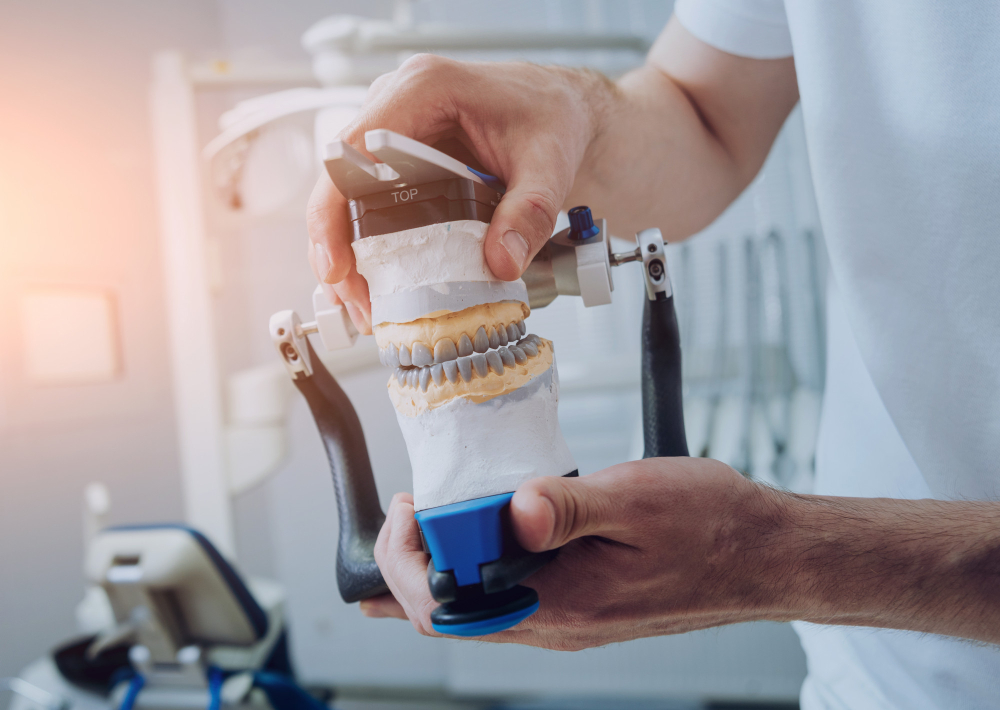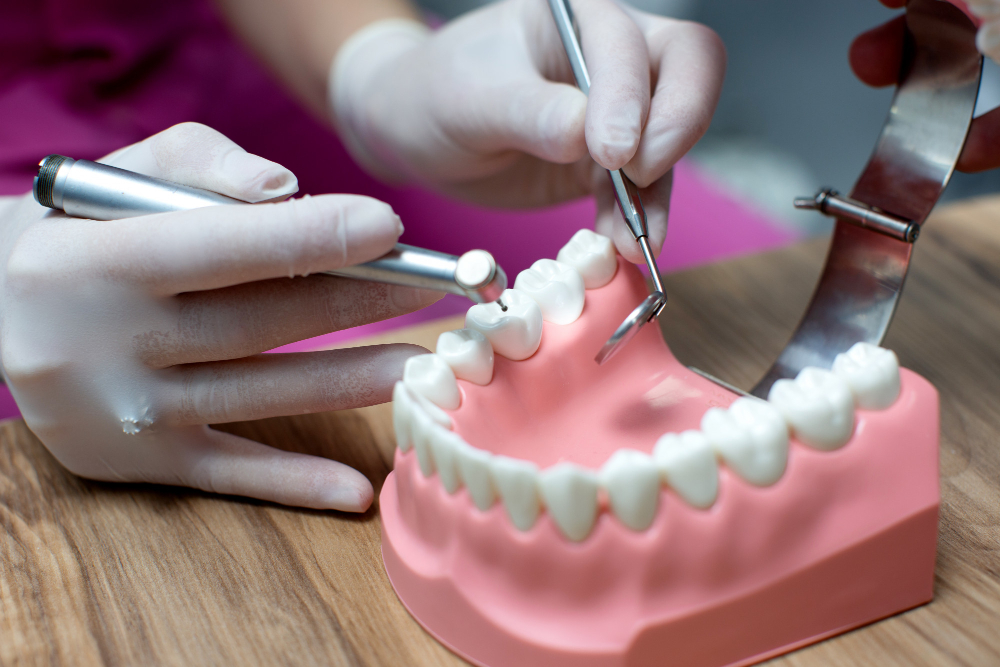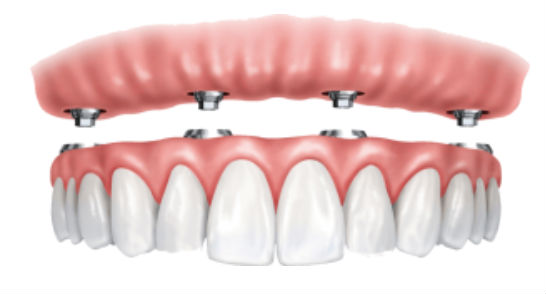Prosthodontics
What is Prosthodontics?
Prosthodontics, also referred to as dental prosthetics or prosthetic dentistry, is one of the nine dental specialties recognized by the American Dental Association (ADA). It is primarily concerned with the diagnosis, treatment planning, rehabilitation, and maintenance of oral function, comfort, appearance, and health of patients with clinical conditions related to missing or deficient teeth and oral and maxillofacial tissues. The specialty utilizes biocompatible prostheses for these purposes.

The term ‘Prosthodontics’ is derived from the Greek words ‘prosthesis’, meaning to add to, and ‘odont’, meaning tooth. In essence, prosthodontics involves the addition to deficient teeth or replacement of missing ones using artificial materials such as porcelain, resins, and metals. However, its scope extends beyond teeth to include the replacement and reconstruction of other parts of the mouth and face like the gums, jaw structure, and even facial parts like the nose or eye in cases of injury or disease.
Prosthodontic procedures can be categorized as removable (like dentures), fixed (like bridges and crowns), or implant-based (like dental implants), depending on the patient’s needs and conditions.
Prosthodontics plays a significant role in oral health, especially for individuals dealing with complex dental problems that go beyond regular tooth decay or gum disease. Its procedures are designed to provide comprehensive rehabilitation for the oral cavity, preserving aesthetics, comfort, and functionality.
In a nutshell, prosthodontics is committed to improving patients’ quality of life, enabling them to chew, smile, speak, and interact confidently without discomfort or self-consciousness.
Role and Responsibilities of a Prosthodontist
A prosthodontist is a dental specialist who, after completing dental school, invests an additional three or more years in an ADA-accredited prosthodontic graduate program. Their expertise lies in addressing dental and facial issues that require the restoration of missing tooth and jaw structures, a crucial component of oral health and facial aesthetics.
The central duty of a prosthodontist involves the comprehensive evaluation, diagnosis, planning, and execution of clinical treatments aimed at restoring the optimal function and aesthetics of a patient’s smile. Let’s delve into the key responsibilities of a prosthodontist:
- Diagnosis and treatment planning: They conduct thorough examinations to diagnose and formulate treatment plans for patients with intricate dental conditions involving missing or deficient teeth. This ensures the patient’s aesthetic, comfort, and functional needs are met.
- Treatments: Prosthodontists perform both removable and fixed prosthodontic treatments. These include full and partial dentures, bridges, crowns, veneers, inlays, onlays, and dental implants.
- Maxillofacial Prosthetic Treatment: Prosthodontists extend their expertise beyond teeth restoration. They also provide prostheses for individuals with mouth and facial defects or disabilities, such as those resulting from oral cancer, trauma, or congenital defects.
- Collaboration: Prosthodontists often spearhead a dental team in managing complex dental cases. They work in tandem with other dental specialists and healthcare professionals to develop a multi-disciplinary treatment plan for patients.
- Education: Leveraging their extensive knowledge and training, prosthodontists contribute to education and research. They guide other dentists about the latest procedures and advancements in the field of prosthodontics.
In essence, prosthodontists leverage their specialized skills and training to provide accurate diagnoses and tailor treatment plans, thereby enhancing the patient’s oral function, appearance, and overall quality of life.
Prosthodontic Treatments and Their Purpose
Prosthodontic treatments encompass a broad spectrum, each designed to tackle specific dental or oral conditions. These treatments aim to restore natural teeth, replace missing teeth, and in some instances, sculpt or create structures to complete the oral and facial profile aesthetically and functionally.
The primary objective across all prosthodontic procedures is to bolster oral functionality and aesthetics, thereby enhancing the patient’s overall quality of life. Specific treatments such as dental implants, dentures, and crowns and bridges each serve unique purposes. They fill voids, correct bite issues, and restore normal oral functionality.
For instance, dental implants are used to replace missing teeth, providing a stable and long-lasting solution. Dentures, on the other hand, can replace a full or partial set of teeth, offering flexibility and ease of use. Crowns and bridges are employed to rectify damaged teeth or fill gaps left by missing teeth.
Dental Implants
When it comes to tooth replacement, dental implants are a game-changer. These artificial roots, crafted from biocompatible materials like titanium or zirconium, serve as a sturdy foundation for a crown, bridge, or denture. The surgical insertion of these implants into the jawbone allows them to fuse with the bone tissue, a phenomenon known as osseointegration. The result? A solution that not only looks like a natural tooth but also performs like one.
Dental implants come in two varieties: endosteal and subperiosteal. The former, which is the more popular choice, is embedded in the jawbone, while the latter sits on the bone beneath the gum tissue.
But dental implants do more than just fill in the gaps in your smile. They also play a crucial role in preserving jawbone health, preventing the bone loss that often follows tooth extraction. With their exceptional stability, dental implants won’t move around in your mouth, unlike some other dental restorations. This stability enhances comfort, chewing efficiency, and speech, while also preserving the natural contours of your face and smile.
However, dental implants aren’t for everyone. Successful placement requires a certain amount of healthy bone, and factors like overall health, oral hygiene, and lifestyle habits such as smoking can impact the success of the implants. Therefore, a comprehensive evaluation by a skilled prosthodontist is essential for anyone contemplating this treatment option.

With proper care and regular dental check-ups, dental implants can potentially last a lifetime. The crown, bridge, or denture attached to the implant may need replacement due to normal wear and tear over time.
While dental implants can revolutionize smiles and boost oral function, they do require a surgical procedure. Therefore, diligent care during the healing period and beyond is crucial, just as it is for natural teeth.

Dentures
Dentures, removable oral appliances designed to replace missing teeth and surrounding tissues, come in two main types: complete and partial. Complete dentures are used when all teeth are missing in a jaw, while partial dentures come into play when some natural teeth remain.
Complete dentures can be conventional or immediate. Conventional dentures are made after the teeth have been removed and the gum tissue has healed, usually after 4 to 6 weeks. During this period, the patient will be without teeth. Immediate dentures, on the other hand, are pre-made and can be positioned as soon as the teeth are removed, eliminating the toothless period. However, these dentures may need frequent adjustments during the healing period as the gums shrink and change shape. Immediate dentures may also require a reline after the gums complete the healing period. This will ensure that the dentures fit adequately on the healed tissue. In some rare occasions, it may be necessary to make a completely new denture.
Partial dentures consist of replacement teeth attached to a gum-colored plastic base. Partials are designed to fill gaps created by missing teeth, preventing other teeth from shifting position and restoring function and esthetics. There are different types of partial dentures to consider.
- A cast metal framework partial: A metal framework holds the denture in place. Acrylic resin is bonded to the framework and the teeth are bonded to the acrylic. The cast metal partial is a sturdy solution that will last you for many years. Cast metal partials do have metal clasps (attachments) that may show when smiling, talking or laughing.
- A Valplast partial: Valpasts are becoming more commonly used due to their flexibility, thin structure and the fact that they are metal-free. Metal-free partials made from Valplasts may be a more ideal solution for patients that prioritize aesthetics over function and longevity. Valplasts may not be ideal for patients that anticipate that they may have more teeth extracted in the future. That is because a Valplast partial cannot be easily modified and it is often easier to remake them than to add missing teeth to them.
- An Acetal Partial:
An acetal partial is another metal-free partial option. These partials are fabricated using CAD/CAM technology. They are made using a zirconium framework and are often shade matched for maximum aesthetics. - Acrylic partial: An acrylic partial is a partial that is designed with no metal framework. It has an acrylic/ resin base and metal clasps for maximum retention. Also known as a stayplate, they are ideal for temporary solutions or for patients on a limited budget.
- A flipper: A flipper is a temporary replacement option usually used to replace one missing front tooth while you wait for a more permanent solution like a dental implant. Flippers can be fabricated very quickly. Usually in a matter of days. They are meant to only be used for a short period of time and are not meant to be functional. They are only there to provide a temporary solution.
Dentures and partials not only enhance a person’s ability to chew and speak clearly, but they also provide support for facial muscles, improving facial aesthetics. Although custom-made to fit comfortably, dentures and partials may require an adjustment period, with potential initial difficulties in speech and chewing.
The lifespan of dentures and partials varies due to factors like wear and tear, changes in the mouth’s shape, and proper care. Regular check-ups and maintenance are necessary to adjust, repair, or replace dentures and partials, ensuring oral health and comfort.
Dentures and partials provide an affordable and effective solution for tooth loss. However, they require regular cleaning, proper storage, and a good oral hygiene routine to avoid dental problems like gum disease and oral thrush. Even with the best care, dentures and partials should be replaced every five to seven years to maintain an optimal fit and function.
Crowns and Bridges
Unlike removable dentures, crowns and bridges are fixed prosthetic solutions, firmly cemented onto existing teeth or implants. They offer a stable and long-lasting solution for damaged or missing teeth.
A crown, often referred to as a ‘cap’, is designed to entirely encase a damaged tooth. This not only fortifies the tooth but also enhances its appearance, shape, and alignment. For instance, consider a tooth that has been severely discolored due to an injury. A porcelain or ceramic crown, known for their natural resemblance, can be used to cover this tooth, restoring its original color and overall appearance. Additionally, crowns can be placed on implants, mimicking the shape and function of a natural tooth.
Bridges, on the other hand, are ideal for those missing one or more teeth. The absence of teeth can cause the remaining ones to shift or rotate into the vacant spaces, leading to a misaligned bite and potential gum disease. A bridge, as the name suggests, spans this gap. It uses the natural teeth or implants on either side of the gap as anchors, onto which the replacement tooth, or pontic, is attached.
Both crowns and bridges not only enhance the aesthetics of your smile but also restore essential oral functions such as proper chewing and speech. Moreover, they help prevent future complications that could arise from damaged or missing teeth.
Maintaining crowns and bridges is akin to caring for your natural teeth. Regular brushing, flossing, and professional cleanings can extend their lifespan, which typically ranges from 5 to 15 years, depending on oral hygiene and lifestyle habits. However, like natural teeth, they can also experience wear and tear and may occasionally require professional intervention.


Benefits of Prosthodontic Treatments
Prosthodontic treatments offer a wealth of benefits that extend beyond oral health, impacting overall quality of life. At their core, these treatments aim to restore your mouth’s functionality, enabling you to eat, speak, and smile with renewed confidence.
These treatments are designed to replace missing teeth, enhance the appearance of natural teeth, and in some cases, reconstruct oral and facial structures. By doing so, they restore balance and integrity to your oral functioning and facial aesthetics. This, in turn, contributes to better nutrition, improved self-esteem, and a more positive outlook on life.
Each specific treatment, be it implants, dentures, crowns, or bridges, brings its unique benefits. For example, implants provide a stable and natural-looking replacement for missing teeth, while dentures offer a removable and cost-effective solution. Crowns can restore the strength and appearance of a damaged tooth, and bridges can effectively fill the gaps left by missing teeth. Together, these treatments contribute to a healthier mouth and a more confident smile.
Improving Aesthetics with Prosthodontics
Prosthodontics is not merely about restoring oral functionality; it is also an art form that enhances aesthetics, contributing significantly to an individual’s self-esteem and confidence. A radiant smile can transform a face, and prosthodontics is the key to achieving this transformation, especially when dealing with missing, discolored, or damaged teeth.
Tailored to each patient’s unique needs, prosthodontic treatments offer a variety of solutions. Consider dental implants, for instance. These are designed to match natural teeth, replacing missing ones without affecting the surrounding healthy teeth. They also provide support for the facial profile. When meticulously crafted and skillfully placed, dental implants can mimic natural teeth, integrating seamlessly into the oral environment.
Dentures, another prosthodontic solution, can be customized to enhance a patient’s facial features. A well-constructed full denture not only replicates natural gum tissue and teeth but also provides support to the lips and cheeks, preventing the sunken facial appearance often linked with tooth and bone loss.
Crowns and bridges, while rehabilitating damaged or missing teeth, are also frequently employed for cosmetic corrections. Crowns can conceal discolored or misshapen teeth, while bridges fill gaps, creating a harmonious and appealing smile line.
Prosthodontics also plays a significant role in full-mouth reconstruction, where meticulous planning and multiple procedures come together to create a fully functional and aesthetically pleasing oral landscape. Whether it’s correcting minor chips or cracks or addressing significant restorative needs, prosthodontics is instrumental in designing and enhancing smiles.
How Prosthodontics Restores Oral Functionality
Prosthodontics is a cornerstone of oral functionality restoration, which encompasses essential daily activities such as eating, speaking, and maintaining proper oral hygiene. When teeth are lost or damaged, prosthodontic intervention becomes crucial.
Take dental implants, for example. They function like natural tooth roots, providing a sturdy foundation for crowns, bridges, or dentures. These implants remain firmly anchored in the mouth, eliminating the discomfort and instability often associated with removable dentures. This stability allows patients to enjoy a variety of foods without concern.
Dentures, whether full or partial, replace missing teeth, thereby enhancing the ability to chew and speak. They distribute the forces in your mouth evenly when you eat, reducing pressure on gums and surrounding teeth. Dentures also support the cheeks and lips, thereby improving speech and appearance.
Crowns serve to salvage and fortify damaged teeth, enabling them to function normally. They restore the original shape and size of the teeth, allowing for normal biting and chewing. By encapsulating the affected tooth, a crown prevents further breakdown and reduces the risk of additional bacterial infections.
Bridges, on the other hand, replace one or more missing teeth, filling in the gaps and preventing the remaining teeth from shifting out of position. This shifting can lead to malocclusion (bad bite) or temporomandibular joint disorders. By restoring the complete dental arch, bridges restore the ability to chew food evenly on both sides and speak clearly.
In essence, by restoring missing or damaged teeth, prosthodontics significantly contributes to better nutrition, clear speech, and a healthier smile, ultimately leading to improved overall wellbeing.
Important Considerations in Prosthodontics
Embarking on the journey of prosthodontic treatment is a significant decision that requires careful thought and consideration. While the benefits of such treatments are plentiful, it’s essential to weigh them against several critical factors. These include the financial investment, the time commitment for the procedure and recovery, and the necessary aftercare. By taking these elements into account, you can ensure that you are making a well-rounded decision that will lead you towards a healthier and more radiant smile.
Understanding the Cost of Prosthodontic Treatments
Navigating the financial aspects of prosthodontic treatments can seem daunting due to the numerous variables involved. The type of treatment you choose, be it dental implants, dentures, crowns, or bridges, will significantly influence the overall cost. For example, dental implants, which involve surgical intervention, are generally more expensive than conventional dentures.
The complexity of your case and the preparatory work required also factor into the total cost. Some procedures may necessitate additional treatments, such as bone grafting for dental implants or root canal treatment for crowns. Furthermore, the geographical location and the prosthodontist’s level of expertise can also impact the cost.
The quality and type of material used for the prosthetic is another consideration. Higher quality prosthetics, known for their durability and natural appearance, tend to carry a higher price tag.
While the initial cost of these treatments may seem high, it’s important to view them as an investment in your long-term oral health. By replacing missing teeth, you can prevent further oral health issues that could result in more costly treatments down the line.
It’s advisable to consult with your dental insurance provider to understand your coverage for prosthodontic treatments. This can significantly alleviate the financial burden. Additionally, many dental clinics offer payment plans or financing options, providing more flexibility for patients. By considering all these factors, you can gain a holistic understanding of the financial commitment involved in prosthodontic treatments.
Procedure and Recovery in Prosthodontics
The journey to a restored smile through prosthodontics is a process that varies depending on the treatment type.
Take dental implants, for instance. This procedure is typically spread over several appointments. It begins with the surgical insertion of a titanium post into the jawbone, serving as a new ‘root’ for the tooth. A period of healing follows, allowing for osseointegration, the fusion of the implant with the bone. Once healed, an abutment is attached to the implant, and finally, the crown is placed, completing the restoration.
In contrast, the creation of dentures involves taking precise impressions of your mouth to craft a custom set of removable teeth. The denture could be full or partial, depending on if you are replacing all of the teeth in the entire arch (full denture) or just some missing teeth (partial denture).
The process for crowns and bridges is somewhat similar. It involves reshaping the affected tooth, taking an impression, and placing a temporary crown. The permanent crown is cemented in place during a subsequent visit, after ensuring a proper fit and color match. A bridge procedure follows a similar path, but it includes preparing the teeth on either side of the gap to anchor the bridge.
Recovery times differ across treatments. Dental implants, being surgical, may cause swelling and discomfort for a few days, followed by a months-long period for osseointegration. Denture wearers might experience initial discomfort and mouth soreness, which should subside as the mouth adjusts. Crowns and bridges may cause minor tooth sensitivity that generally diminishes over time.
During recovery, a diet of soft foods is typically recommended, and over-the-counter pain medications can help manage discomfort. Remember, each dental procedure aims to improve oral health, so any temporary inconvenience during recovery paves the way for long-term benefits.
Post-Treatment Care in Prosthodontics
The success of any prosthodontic treatment hinges on proper aftercare. Each treatment, whether it’s dental implants, dentures, crowns, or bridges, requires a specific care regimen to ensure long-term effectiveness.
For dental implants, a rigorous oral hygiene routine is paramount. This includes daily brushing, flossing, and regular dental check-ups. Steering clear of hard foods can also prevent potential damage.
Dentures, meanwhile, need a unique care routine. They should be removed nightly and cleaned to eliminate food particles and plaque. Using a soft toothbrush or a denture cleaner, gently clean the dentures and soak them in a special solution overnight. Regular dental check-ups are also crucial to assess the fit and check for signs of damage or gum disease.
Crowns and bridges require care akin to natural teeth. Daily brushing and flossing around these areas are vital as they can still accumulate plaque. Special flossers are available for cleaning under and around bridges. Regular dental check-ups and cleanings can help detect early signs of failure.
While these specific care routines are important, maintaining overall oral health is equally crucial. This includes refraining from smoking, limiting sugary and acidic foods, and maintaining a regular dental routine—brushing twice a day, flossing daily, and scheduling regular dentist visits.
Regardless of the prosthodontic treatment, regular follow-ups with your prosthodontist are essential to monitor and address any potential issues promptly. This diligent post-treatment care not only ensures the longevity of your dental prosthesis but also promotes overall oral health.
Schedule Today!
We look forward to meeting you. Call us or request an appointment online to set up your first visit. We’ll be in touch soon.

